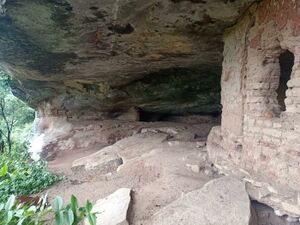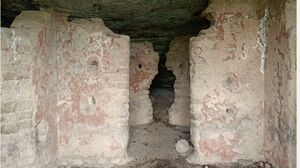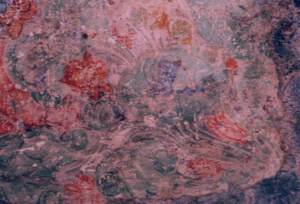Aruma Mount Cave Temple
இந்தப் பக்கத்தை தமிழில் வாசிக்க: அருமா மலை குகைக்கோயில்
Aruma Mount Cave Temple or Arumamalai Cave Temple (7th-8th century AD) is a Jain cave temple located in the North Arcot district of Tamil Nadu. This is one of the few places with ancient Jain paintings in Tamil Nadu.
Location
Arumamalai is located in the Gudiyatham district of North Arcot, about 1 km west of Malaiyampattu. You can reach Malayampattu from Ambur and reach this hill from there. This mount was probably once called as Arukar Mamalai (Mount of the Jains) which was abbreviated to Arumamalai.
Cave
In the middle of the mount is a large cave 131 feet long. This was a Jain palli inhabited by monks in ancient times. There are no stone beds (padugai), Jain sculptures or stone inscriptions. As the cave's floor is covered in stones and dirt, the stone beds could have become buried in it. Three brick rooms are located inside the cave, with a mandapa in front of them. The walls of the temple are raised up to the roof of the cave, so the canopy of the cave forms the roof. The walls of the temple have been deteriorating as it is built of unbaked brick.[1]
It is difficult to ascertain the time period of the temple. Archaeological evidence dates it back to 8th century. According to this, the Jain religion may have prevailed in the same century.[2]
Sculptures
There are no sculptures in the Arumamalai cave temple. On the way to this hill, an abandoned Tirthankara sculpture is said to have been found many years ago. Only three Dwarapalaka (guardian or gatekeeper deities of the temple) sculptures adorning the sanctum sanctorum entrances of the temple can be seen. Two of these have been split into two pieces, while the third has been shattered into multiple parts.
The first two sculptures are identical, with the right hand holding the anjali mudra (pay tribute) pointing upwards and the left hand resting on the gadhayudha (mace). Their right leg is planted firmly on the ground, while their left leg is slightly bent backwards.
The cone-shaped turban, the strap necklace, the flat punul (sacred thread), and the udarabandam (male hip ornament) are all very simple without the decorative embellishments on these sculptures.
Both sculptures have a radiant countenance and a long, slender figure. Their gadhayudha is notable for having an unusual mid section formed like a bottle-guard, a sharp edge, and a sword-like handle. These sculptures show the pallava art from the eighth century. Both of these sculptures are slightly slanted to the left and have the gadhayudha on the left hand, suggesting that they were installed to the right of the sanctum sanctorum gates.
The third sculpture has the same artistic features as the other two dwarabalakas, but it is leaning to the right and has the gadhayudha on the right hand suggesting that they were installed towards the left of the sanctum sanctorum gates. Head of the third sculpture is missing and its body is shattered into five or six pieces.
These don't have the murderous face that dwarapalaka statues generally have. The makuda (crown) is replaced with a turban. In their makuda, Saiva and Vaishnava temple dwarapalakas have weapons of their respective deities, such as chakra, scepter, or parasu but the Arumamalai dwarapalakas do not have them.
Paintings
Color paintings from the eighth century adorn the roof of the cave and the walls of the temple. Ponds filled with lotus flowers, buds and vines are portrayed with swans and elephants playing merrily. This is an illustration of Gadhikabumi from Jain literature. There are also paintings depicting Dikbalar. Many of these paintings are in a state of ruin(A. Ekamparanathan).
Notes
- Montgomery and T. S. Baskaran, "The Armamalai Paintings" Lalitkala, No. 16, pp. 22-28
- R. Nagaswamy, "Jaina Monuments in Tamilnadu", Tamil Arasu, Nov. 1974
- Montgomery & T. S. Baskarand, op. cit, plate. VII figs. 2-4
References
Footnotes
✅Finalised Page



